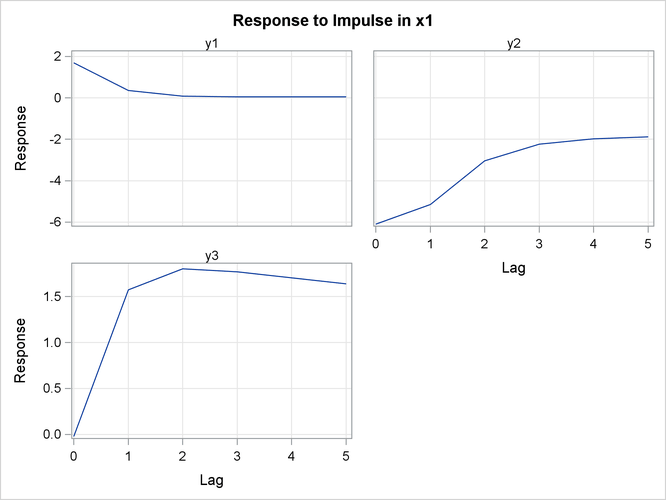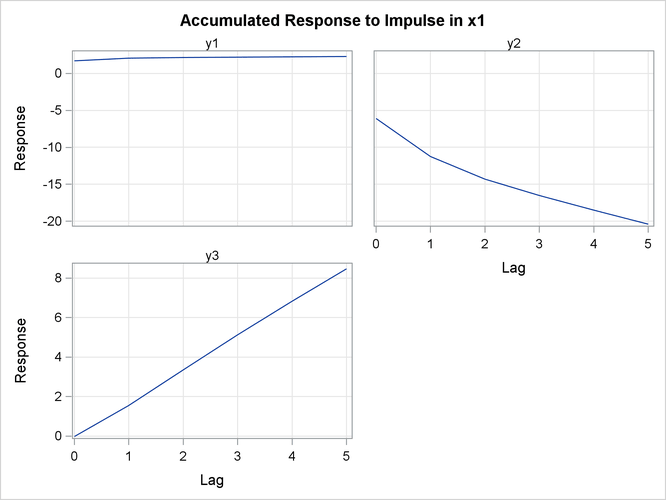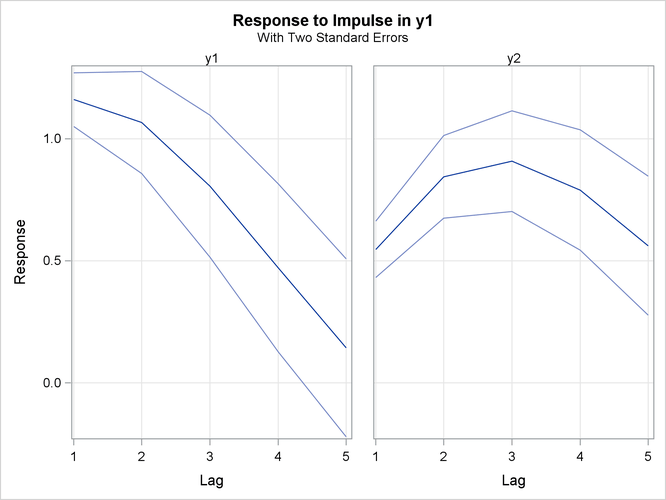The VARMAX Procedure
- Overview
-
Getting Started

-
Syntax

-
Details
 Missing ValuesVARMAX ModelDynamic Simultaneous Equations ModelingImpulse Response FunctionForecastingTentative Order SelectionVAR and VARX ModelingBayesian VAR and VARX ModelingVARMA and VARMAX ModelingModel Diagnostic ChecksCointegrationVector Error Correction ModelingI(2) ModelMultivariate GARCH ModelingOutput Data SetsOUT= Data SetOUTEST= Data SetOUTHT= Data SetOUTSTAT= Data SetPrinted OutputODS Table NamesODS GraphicsComputational Issues
Missing ValuesVARMAX ModelDynamic Simultaneous Equations ModelingImpulse Response FunctionForecastingTentative Order SelectionVAR and VARX ModelingBayesian VAR and VARX ModelingVARMA and VARMAX ModelingModel Diagnostic ChecksCointegrationVector Error Correction ModelingI(2) ModelMultivariate GARCH ModelingOutput Data SetsOUT= Data SetOUTEST= Data SetOUTHT= Data SetOUTSTAT= Data SetPrinted OutputODS Table NamesODS GraphicsComputational Issues -
Examples

- References
Impulse Response Function
- Simple Impulse Response Function (IMPULSE=SIMPLE Option)
- Accumulated Impulse Response Function (IMPULSE=ACCUM Option)
- Orthogonalized Impulse Response Function (IMPULSE=ORTH Option)
- Impulse Response of Transfer Function (IMPULSX=SIMPLE Option)
- Impulse Response of Transfer Function (IMPULSX=ACCUM Option)
Simple Impulse Response Function (IMPULSE=SIMPLE Option)
The VARMAX(![]() ,
,![]() ,
,![]() ) model has a convergent representation
) model has a convergent representation
|
|
where ![]() and
and ![]() .
.
The elements of the matrices ![]() from the operator
from the operator ![]() , called the impulse response, can be interpreted as the impact that a shock in one variable has on another variable. Let
, called the impulse response, can be interpreted as the impact that a shock in one variable has on another variable. Let
![]() be the
be the ![]() element of
element of ![]() at lag
at lag ![]() , where
, where ![]() is the index for the impulse variable, and
is the index for the impulse variable, and ![]() is the index for the response variable (impulse
is the index for the response variable (impulse ![]() response). For instance,
response). For instance, ![]() is an impulse response to
is an impulse response to ![]() , and
, and ![]() is an impulse response to
is an impulse response to ![]() .
.
Accumulated Impulse Response Function (IMPULSE=ACCUM Option)
The accumulated impulse response function is the cumulative sum of the impulse response function, ![]() .
.
Orthogonalized Impulse Response Function (IMPULSE=ORTH Option)
The MA representation of a VARMA(![]() ,
,![]() ) model with a standardized white noise innovation process offers another way to interpret a VARMA(
) model with a standardized white noise innovation process offers another way to interpret a VARMA(![]() ,
,![]() ) model. Since
) model. Since ![]() is positive-definite, there is a lower triangular matrix
is positive-definite, there is a lower triangular matrix ![]() such that
such that ![]() . The alternate MA representation of a VARMA(
. The alternate MA representation of a VARMA(![]() ,
,![]() ) model is written as
) model is written as
|
|
where ![]() ,
, ![]() , and
, and ![]() .
.
The elements of the matrices ![]() , called the orthogonal impulse response, can be interpreted as the effects of the components of the standardized shock process
, called the orthogonal impulse response, can be interpreted as the effects of the components of the standardized shock process ![]() on the process
on the process ![]() at lag
at lag ![]() .
.
Impulse Response of Transfer Function (IMPULSX=SIMPLE Option)
The coefficient matrix ![]() from the transfer function operator
from the transfer function operator ![]() can be interpreted as the effects that changes in the exogenous variables
can be interpreted as the effects that changes in the exogenous variables ![]() have on the output variable
have on the output variable ![]() at lag
at lag ![]() ; it is called an impulse response matrix in the transfer function.
; it is called an impulse response matrix in the transfer function.
Impulse Response of Transfer Function (IMPULSX=ACCUM Option)
The accumulated impulse response in the transfer function is the cumulative sum of the impulse response in the transfer function,
![]() .
.
The asymptotic distributions of the impulse functions can be seen in the section VAR and VARX Modeling.
The following statements provide the impulse response and the accumulated impulse response in the transfer function for a VARX(1,0) model.
proc varmax data=grunfeld plot=impulse;
model y1-y3 = x1 x2 / p=1 lagmax=5
printform=univariate
print=(impulsx=(all) estimates);
run;
In Figure 36.26, the variables ![]() and
and ![]() are impulses and the variables
are impulses and the variables ![]() ,
, ![]() , and
, and ![]() are responses. You can read the table matching the pairs of
are responses. You can read the table matching the pairs of ![]() such as
such as ![]() ,
, ![]() ,
, ![]() ,
, ![]() ,
, ![]() , and
, and ![]() . In the pair of
. In the pair of ![]() , you can see the long-run responses of
, you can see the long-run responses of ![]() to an impulse in
to an impulse in ![]() (the values are 1.69281, 0.35399, 0.09090, and so on for lag 0, lag 1, lag 2, and so on, respectively).
(the values are 1.69281, 0.35399, 0.09090, and so on for lag 0, lag 1, lag 2, and so on, respectively).
Figure 36.26: Impulse Response in Transfer Function (IMPULSX= Option)
| Simple Impulse Response of Transfer Function by Variable |
|||
|---|---|---|---|
| Variable Response\Impulse |
Lag | x1 | x2 |
| y1 | 0 | 1.69281 | -0.00859 |
| 1 | 0.35399 | 0.01727 | |
| 2 | 0.09090 | 0.00714 | |
| 3 | 0.05136 | 0.00214 | |
| 4 | 0.04717 | 0.00072 | |
| 5 | 0.04620 | 0.00040 | |
| y2 | 0 | -6.09850 | 2.57980 |
| 1 | -5.15484 | 0.45445 | |
| 2 | -3.04168 | 0.04391 | |
| 3 | -2.23797 | -0.01376 | |
| 4 | -1.98183 | -0.01647 | |
| 5 | -1.87415 | -0.01453 | |
| y3 | 0 | -0.02317 | -0.01274 |
| 1 | 1.57476 | -0.01435 | |
| 2 | 1.80231 | 0.00398 | |
| 3 | 1.77024 | 0.01062 | |
| 4 | 1.70435 | 0.01197 | |
| 5 | 1.63913 | 0.01187 | |
Figure 36.27 shows the responses of ![]() ,
, ![]() , and
, and ![]() to a forecast error impulse in
to a forecast error impulse in ![]() .
.
Figure 36.27: Plot of Impulse Response in Transfer Function

Figure 36.28 shows the accumulated impulse response in transfer function.
Figure 36.28: Accumulated Impulse Response in Transfer Function (IMPULSX= Option)
| Accumulated Impulse Response of Transfer Function by Variable |
|||
|---|---|---|---|
| Variable Response\Impulse |
Lag | x1 | x2 |
| y1 | 0 | 1.69281 | -0.00859 |
| 1 | 2.04680 | 0.00868 | |
| 2 | 2.13770 | 0.01582 | |
| 3 | 2.18906 | 0.01796 | |
| 4 | 2.23623 | 0.01867 | |
| 5 | 2.28243 | 0.01907 | |
| y2 | 0 | -6.09850 | 2.57980 |
| 1 | -11.25334 | 3.03425 | |
| 2 | -14.29502 | 3.07816 | |
| 3 | -16.53299 | 3.06440 | |
| 4 | -18.51482 | 3.04793 | |
| 5 | -20.38897 | 3.03340 | |
| y3 | 0 | -0.02317 | -0.01274 |
| 1 | 1.55159 | -0.02709 | |
| 2 | 3.35390 | -0.02311 | |
| 3 | 5.12414 | -0.01249 | |
| 4 | 6.82848 | -0.00052 | |
| 5 | 8.46762 | 0.01135 | |
Figure 36.29 shows the accumulated responses of ![]() ,
, ![]() , and
, and ![]() to a forecast error impulse in
to a forecast error impulse in ![]() .
.
Figure 36.29: Plot of Accumulated Impulse Response in Transfer Function

The following statements provide the impulse response function, the accumulated impulse response function, and the orthogonalized impulse response function with their standard errors for a VAR(1) model. Parts of the VARMAX procedure output are shown in Figure 36.30, Figure 36.32, and Figure 36.34.
proc varmax data=simul1 plot=impulse;
model y1 y2 / p=1 noint lagmax=5
print=(impulse=(all))
printform=univariate;
run;
Figure 36.30 is the output in a univariate format associated with the PRINT=(IMPULSE=) option for the impulse response function. The keyword
STD stands for the standard errors of the elements. The matrix in terms of the lag 0 does not print since it is the identity.
In Figure 36.30, the variables ![]() and
and ![]() of the first row are impulses, and the variables
of the first row are impulses, and the variables ![]() and
and ![]() of the first column are responses. You can read the table matching the
of the first column are responses. You can read the table matching the ![]() pairs, such as
pairs, such as ![]() ,
, ![]() ,
, ![]() , and
, and ![]() . For example, in the pair of
. For example, in the pair of ![]() at lag 3, the response is 0.8055. This represents the impact on y1 of one-unit change in
at lag 3, the response is 0.8055. This represents the impact on y1 of one-unit change in ![]() after 3 periods. As the lag gets higher, you can see the long-run responses of
after 3 periods. As the lag gets higher, you can see the long-run responses of ![]() to an impulse in itself.
to an impulse in itself.
Figure 36.30: Impulse Response Function (IMPULSE= Option)
| Simple Impulse Response by Variable | |||
|---|---|---|---|
| Variable Response\Impulse |
Lag | y1 | y2 |
| y1 | 1 | 1.15977 | -0.51058 |
| STD | 0.05508 | 0.05898 | |
| 2 | 1.06612 | -0.78872 | |
| STD | 0.10450 | 0.10702 | |
| 3 | 0.80555 | -0.84798 | |
| STD | 0.14522 | 0.14121 | |
| 4 | 0.47097 | -0.73776 | |
| STD | 0.17191 | 0.15864 | |
| 5 | 0.14315 | -0.52450 | |
| STD | 0.18214 | 0.16115 | |
| y2 | 1 | 0.54634 | 0.38499 |
| STD | 0.05779 | 0.06188 | |
| 2 | 0.84396 | -0.13073 | |
| STD | 0.08481 | 0.08556 | |
| 3 | 0.90738 | -0.48124 | |
| STD | 0.10307 | 0.09865 | |
| 4 | 0.78943 | -0.64856 | |
| STD | 0.12318 | 0.11661 | |
| 5 | 0.56123 | -0.65275 | |
| STD | 0.14236 | 0.13482 | |
Figure 36.31 shows the responses of ![]() and
and ![]() to a forecast error impulse in
to a forecast error impulse in ![]() with two standard errors.
with two standard errors.
Figure 36.31: Plot of Impulse Response

Figure 36.32 is the output in a univariate format associated with the PRINT=(IMPULSE=) option for the accumulated impulse response function. The matrix in terms of the lag 0 does not print since it is the identity.
Figure 36.32: Accumulated Impulse Response Function (IMPULSE= Option)
| Accumulated Impulse Response by Variable | |||
|---|---|---|---|
| Variable Response\Impulse |
Lag | y1 | y2 |
| y1 | 1 | 2.15977 | -0.51058 |
| STD | 0.05508 | 0.05898 | |
| 2 | 3.22589 | -1.29929 | |
| STD | 0.21684 | 0.22776 | |
| 3 | 4.03144 | -2.14728 | |
| STD | 0.52217 | 0.53649 | |
| 4 | 4.50241 | -2.88504 | |
| STD | 0.96922 | 0.97088 | |
| 5 | 4.64556 | -3.40953 | |
| STD | 1.51137 | 1.47122 | |
| y2 | 1 | 0.54634 | 1.38499 |
| STD | 0.05779 | 0.06188 | |
| 2 | 1.39030 | 1.25426 | |
| STD | 0.17614 | 0.18392 | |
| 3 | 2.29768 | 0.77302 | |
| STD | 0.36166 | 0.36874 | |
| 4 | 3.08711 | 0.12447 | |
| STD | 0.65129 | 0.65333 | |
| 5 | 3.64834 | -0.52829 | |
| STD | 1.07510 | 1.06309 | |
Figure 36.33 shows the accumulated responses of ![]() and
and ![]() to a forecast error impulse in
to a forecast error impulse in ![]() with two standard errors.
with two standard errors.
Figure 36.33: Plot of Accumulated Impulse Response

Figure 36.34 is the output in a univariate format associated with the PRINT=(IMPULSE=) option for the orthogonalized impulse response
function. The two right-hand side columns, ![]() and
and ![]() , represent the
, represent the ![]() and
and ![]() variables. These are the impulses variables. The left-hand side column contains responses variables,
variables. These are the impulses variables. The left-hand side column contains responses variables, ![]() and
and ![]() . You can read the table by matching the
. You can read the table by matching the ![]() pairs such as
pairs such as ![]() ,
, ![]() ,
, ![]() , and
, and ![]() .
.
Figure 36.34: Orthogonalized Impulse Response Function (IMPULSE= Option)
| Orthogonalized Impulse Response by Variable | |||
|---|---|---|---|
| Variable Response\Impulse |
Lag | y1 | y2 |
| y1 | 0 | 1.13523 | 0.00000 |
| STD | 0.08068 | 0.00000 | |
| 1 | 1.13783 | -0.58120 | |
| STD | 0.10666 | 0.14110 | |
| 2 | 0.93412 | -0.89782 | |
| STD | 0.13113 | 0.16776 | |
| 3 | 0.61756 | -0.96528 | |
| STD | 0.15348 | 0.18595 | |
| 4 | 0.27633 | -0.83981 | |
| STD | 0.16940 | 0.19230 | |
| 5 | -0.02115 | -0.59705 | |
| STD | 0.17432 | 0.18830 | |
| y2 | 0 | 0.35016 | 1.13832 |
| STD | 0.11676 | 0.08855 | |
| 1 | 0.75503 | 0.43824 | |
| STD | 0.06949 | 0.10937 | |
| 2 | 0.91231 | -0.14881 | |
| STD | 0.10553 | 0.13565 | |
| 3 | 0.86158 | -0.54780 | |
| STD | 0.12266 | 0.14825 | |
| 4 | 0.66909 | -0.73827 | |
| STD | 0.13305 | 0.15846 | |
| 5 | 0.40856 | -0.74304 | |
| STD | 0.14189 | 0.16765 | |
In Figure 36.4, there is a positive correlation between ![]() and
and ![]() . Therefore, shock in
. Therefore, shock in ![]() can be accompanied by a shock in
can be accompanied by a shock in ![]() in the same period. For example, in the pair of
in the same period. For example, in the pair of ![]() , you can see the long-run responses of
, you can see the long-run responses of ![]() to an impulse in
to an impulse in ![]() .
.
Figure 36.35 shows the orthogonalized responses of ![]() and
and ![]() to a forecast error impulse in
to a forecast error impulse in ![]() with two standard errors.
with two standard errors.
Figure 36.35: Plot of Orthogonalized Impulse Response
